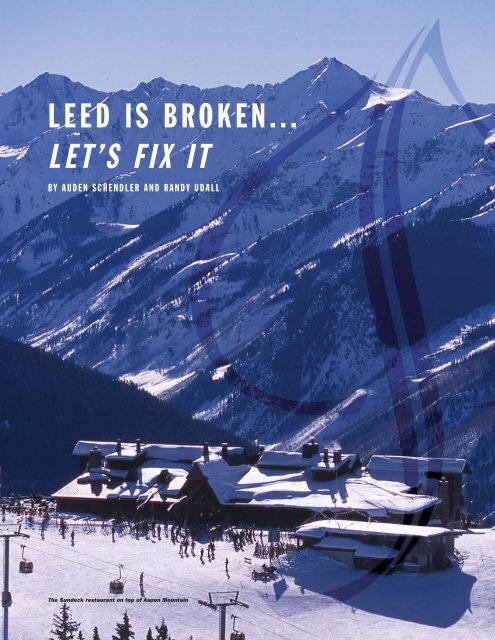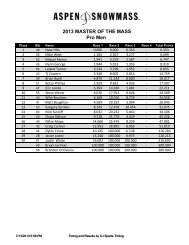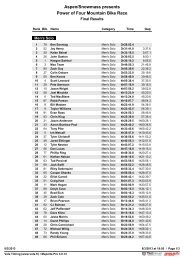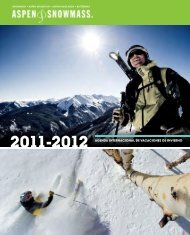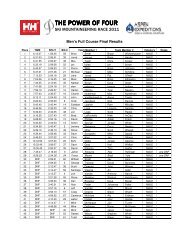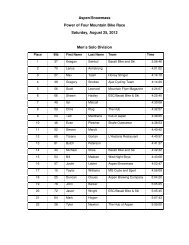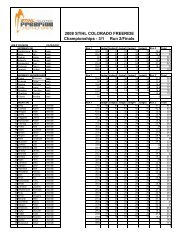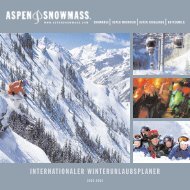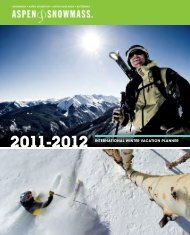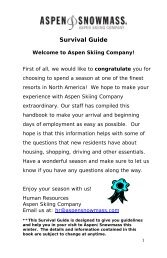LEED is Broken - Aspen/Snowmass
LEED is Broken - Aspen/Snowmass
LEED is Broken - Aspen/Snowmass
Create successful ePaper yourself
Turn your PDF publications into a flip-book with our unique Google optimized e-Paper software.
<strong>LEED</strong> IS BROKEN...<br />
LET’S FIX IT<br />
BY AUDEN SCHENDLER AND RANDY UDALL<br />
The Sundeck restaurant on top of <strong>Aspen</strong> Mountain
<strong>LEED</strong> <strong>is</strong> <strong>Broken</strong>…<br />
Let’s Fix It<br />
© 2005 Auden Schendler and Randy Udall<br />
In the last five years, something exciting has happened in the green building world.<br />
Conferences on the topic used to be love-ins, featuring hippies in beads and Birkenstocks,<br />
with friends of Denn<strong>is</strong> Weaver pitching tire-houses. Okay, it wasn't really that bad...but<br />
close. Recently, however, the U.S. Green Building Council (USGBC) 1 has given the field<br />
a professional sheen, and helped it blossom. The USGBC attracted 8,000 people to its<br />
Portland conference last summer. Many were wearing suits, and the whiff of serious<br />
money was in the air. The head of China's construction admin<strong>is</strong>tration—which will be<br />
responsible for much of the construction the world will see in the coming decade—was<br />
there, and got a standing ovation. There were also product suppliers, architects,<br />
consultants, builders, engineers, academics, doctors and scient<strong>is</strong>ts—the conferences have<br />
become a runaway train of enthusiasm for green buildings.<br />
Much of the excitement results from <strong>LEED</strong> (Leadership in Energy and Environmental<br />
Design), USGBC’s flagship program to rate a building’s environmental performance.<br />
Prior to <strong>LEED</strong>, “green building” was all in the eye of the claimant: you could, for<br />
example, ban smoking and call your restaurant green. Why not? There was no standard,<br />
so any claim was as plausible as the next. <strong>LEED</strong> changed that, tapping a pent-up demand<br />
for reliable information with a rigorous rating system and a checkl<strong>is</strong>t for going green.<br />
Interest in green building <strong>is</strong> timely. The impacts of assembling, heating, cooling, and<br />
electrifying buildings are r<strong>is</strong>ing rapidly. Buildings consume one-quarter of the global<br />
wood harvest, one-sixth of its fresh water, and two-fifths of material and energy flows. 2<br />
In the U.S., buildings account for 65% of electricity consumption and 36% of primary<br />
energy use; operating a typical American house produces 26,000 pounds of greenhouse<br />
gases each year, enough to fill the Goodyear blimp. 3 Since most Americans spend 90% of<br />
their lives indoors, 4 there <strong>is</strong> growing concern about indoor environmental quality, a<br />
contributor to the childhood asthma pandemic and other health problems. In a<br />
provocative essay, Ed Mazria recently noted that buildings are “the most long-lived<br />
1 www.usgbc.org<br />
2 Roodman, D.M. and N. Lenssen. 1995. “A Building Revolution: How Ecology and Health Concerns are<br />
Transforming Construction,” Worldwatch Paper 124. Washington, DC. Worldwatch Institute. p. 5.<br />
3 Stat<strong>is</strong>tics available online at http://www.usgbc.org/Docs/Resources/5. The blimp calculation <strong>is</strong> based on<br />
average household em<strong>is</strong>sions of 26,000 pounds, estimated in "Cool Citizens," Rocky Mountain Institute,<br />
http://www.rmi.org/sitepages/pid173.php. The Goodyear blimp's volume <strong>is</strong> 202,000 cubic feet, equivalent<br />
to about 23,000 pounds of CO2. (Calculation: Udall.)<br />
4 According to the American Lung Association. http://www.alaw.org/air_quality/indoor_air_quality/
physical artifacts society produces.” Since energy use in buildings <strong>is</strong> responsible for<br />
nearly half of the nation’s greenhouse gas em<strong>is</strong>sions, Mazria believes architects are<br />
primarily responsible for resolving the climate challenge. 5<br />
There are nearly 100 million buildings 6 in the U.S. Almost all of them are on life support,<br />
like patients in intensive care. Recognizing that the conventional approach to construction<br />
<strong>is</strong> brain dead, 10,000 design professionals have trained to become “<strong>LEED</strong> accredited.”<br />
Overnight, <strong>LEED</strong> has become a dominant brand, like Nike in athletic shoes or Dell in<br />
personal computers.<br />
When <strong>LEED</strong> was launched, the hope was that it would transform the design and<br />
construction of commercial buildings. But today, for many reasons, <strong>LEED</strong> <strong>is</strong> fast<br />
becoming its own worst enemy. The program’s early bloom <strong>is</strong> fading. Green building has<br />
a robust future, but <strong>LEED</strong> may not.<br />
Within the green building orbit, everyone worth their low-VOC paint has heard about<br />
<strong>LEED</strong>, but the early results have been sorely d<strong>is</strong>appointing. Since 1995, the Energy Star<br />
program, for example, has been embraced by office equipment and home appliance<br />
manufacturers. It has been so widely adopted that it has, effectively, flipped the market<br />
for computers, monitors, printers, copiers, clothes washers, and d<strong>is</strong>hwashers. Over<br />
360,000 of the nation's new homes have earned the Energy Star label, saving<br />
homeowners an estimated $200 million and eliminating approximately 4 billion pounds<br />
of greenhouse gas em<strong>is</strong>sions. Th<strong>is</strong> sort of market transformation <strong>is</strong> what <strong>LEED</strong> aspires to.<br />
Since 2000, however, <strong>LEED</strong> has certified fewer than 200 buildings, with 1772 projects<br />
reg<strong>is</strong>tered but not certified. Manufactured goods aren’t buildings, obviously, so here’s a<br />
more telling compar<strong>is</strong>on: while <strong>LEED</strong> was ploddingly certifying a few dozen projects<br />
each year, the U.S. Department of Energy’s Building America program helped<br />
production builders design and erect more than 20,000 new homes. Although interest in<br />
green building seems to be exploding—with some municipalities, states, and corporations<br />
adopting <strong>LEED</strong> as a standard—the reality <strong>is</strong> that <strong>LEED</strong> <strong>is</strong> deeply troubled. There <strong>is</strong> great<br />
interest, but there are few certified buildings. If <strong>LEED</strong> doesn’t change, it will collapse of<br />
its own weight, with more and more potential users saying “No thanks,” as some<br />
colleges, and many builders, already have. 7<br />
Between the two authors, we’ve built a passive solar home, designed the world’s first<br />
renewable energy mitigation program, participated in the pioneer program that developed<br />
<strong>LEED</strong> 1.0, built two <strong>LEED</strong>-rated buildings (with half a dozen more planned) and played<br />
a consulting role on numerous other green building projects, including a high<br />
performance affordable housing project. We’re concerned that <strong>LEED</strong> has become costly,<br />
5 Mazria, E. 2003. “It's the Architecture, Stupid!” Solar Today, May/June, pp. 48-51.<br />
Available online at http://www.mazria.com/publications.html.<br />
6 In 2002, there were more than 76 million residential buildings and more than 5 million commercial<br />
buildings according to the U.S. Department of Energy. By 2010 another 38 million are expected to be built.<br />
7 Duke and Stanford, for example. Based on notes by Jen Seal from the Urban Land Institute conference<br />
Green Buildings and Sustainable Development: Making the Business Case, August 25 th . <strong>Aspen</strong> Roundtable<br />
2003, in <strong>Aspen</strong>, CO. Th<strong>is</strong> paper later cites other builders who are bailing on <strong>LEED</strong> certification.<br />
2
slow, brutal, confusing, and unwieldy, a death march for applicants admin<strong>is</strong>tered by a<br />
soviet-style bureaucracy that makes green building more difficult than it needs to be, yet<br />
has everyone genuflecting at the door to prove their credentials. The result: mediocre<br />
“green” buildings where certification, not environmental responsibility, <strong>is</strong> the primary<br />
goal; a few super-high level eco-structures built by ultra-motivated (and wealthy) owners<br />
that stand like the Taj Mahal as beacons of impossibility; an explosion of <strong>LEED</strong>accredited<br />
architects and engineers chasing lots of money but designing few buildings;<br />
and a d<strong>is</strong>couraged cadre of professionals who want to build green, but can’t afford to<br />
certify their buildings. 8 A growing number of <strong>LEED</strong> veterans have, or soon will, throw<br />
in the towel. <strong>LEED</strong> <strong>is</strong> broken. Th<strong>is</strong> article explores what went wrong, and begins a<br />
d<strong>is</strong>cussion of how to fix it.<br />
What <strong>is</strong> <strong>LEED</strong>?<br />
<strong>LEED</strong> <strong>is</strong> both a certification system and a how-to guide for professionals new to green<br />
construction. The <strong>LEED</strong> checkl<strong>is</strong>t prompts designers to reduce impacts in five categories<br />
ranging from site planning to energy consumption, water usage, indoor environmental<br />
quality, and building materials. Pay a modest fee, sat<strong>is</strong>fy the prerequ<strong>is</strong>ites, acquire 26 of<br />
67 possible points, and your building can become “<strong>LEED</strong> Certified.” 9<br />
Once a building <strong>is</strong> completed, a developer submits documentation to the USGBC, where<br />
a third-party evaluator determines whether to award a Certified, Silver, Gold, or Platinum<br />
rating. It <strong>is</strong> very difficult to grab the Platinum ring: there are only seven such buildings in<br />
the world. Indeed, it’s hard to get a building certified at all. The program began in 2000,<br />
and there are now just 167 certified projects in 51 states and 14 countries. That’s 167<br />
projects over four years. Transformative? Hardly.<br />
Between the Idea and the Reality<br />
T.S. Eliot wrote that “between the idea and the reality… falls the shadow.” And for a<br />
modern audience, Springsteen sang: “Between our dreams and actions lies th<strong>is</strong> world.”<br />
<strong>LEED</strong> <strong>is</strong> a design process that should, in theory, produce buildings that conserve<br />
resources, reduce operating costs and pollution, help address global warming, improve<br />
marketability and durability, preserve the ozone layer, protect occupant health, and<br />
improve worker productivity. What works in theory should work in practice, but in<br />
practice it sometimes doesn’t. <strong>Aspen</strong> Skiing Company (ASC), where Auden <strong>is</strong> the<br />
environmental affairs director, built one of the first <strong>LEED</strong> certified buildings in the<br />
United States, the Sundeck Restaurant (rated Bronze) on <strong>Aspen</strong> Mountain. ASC recently<br />
8 Indeed some buildings, although they achieve <strong>LEED</strong> certification, are hardly green. Instead, the buildings<br />
are a compilation of green technologies stacked on a standard building, like putting lipstick on a pig, but<br />
more expensive. The Bren School in California, which received a platinum rating, was cited by a well<br />
known green design professional/author as an example of th<strong>is</strong> flaw in the process.<br />
9 The program’s original focus was commercial construction, but it <strong>is</strong> expanding into ex<strong>is</strong>ting buildings,<br />
commercial interiors, and core and shell renovations. Competition from pre-ex<strong>is</strong>ting rating systems has<br />
complicated efforts to develop a <strong>LEED</strong> standard for residential construction, but th<strong>is</strong> <strong>is</strong> in the works.<br />
3
certified a second building, the <strong>Snowmass</strong> Golf Clubhouse, as <strong>LEED</strong> Silver. Th<strong>is</strong> paper<br />
uses ASC’s experiences as case studies.<br />
What Ails <strong>LEED</strong>?<br />
Our diagnos<strong>is</strong> follows, but we encourage readers to seek a second opinion. After<br />
describing five problems dogging the program, we suggest possible fixes. It seems to us<br />
that cosmetic tweaks are unlikely to do the job, and a major revamp <strong>is</strong> needed. Indeed, it<br />
may be that <strong>LEED</strong> <strong>is</strong> terminally ill, that euthanasia should be considered so that it can be<br />
replaced with a more effective program.<br />
We don’t make these suggestions lightly. We recognize that an enormous amount of time<br />
and effort and intelligence has gone into developing the <strong>LEED</strong> program. In the field of<br />
sustainable development, the real heroes are not the theor<strong>is</strong>ts in the ivory tower, but the<br />
grunts in the trenches, making m<strong>is</strong>takes and moving the line forward, one bloody yard at<br />
a time. The foot soldiers of the USGBC and <strong>LEED</strong> are doing th<strong>is</strong>, and they deserve our<br />
profound gratitude.<br />
Our critique aims to make <strong>LEED</strong> easier to use and more popular, not a program just for<br />
the deluded, committed, wealthy or radical. The USGBC itself <strong>is</strong> concerned about the<br />
critic<strong>is</strong>m it <strong>is</strong> hearing, and <strong>is</strong> currently conducting its own internal review. Other<br />
substantive critiques are also available. Jay Stein and Rachel Re<strong>is</strong>s’s E Source paper<br />
addresses two <strong>is</strong>sues not d<strong>is</strong>cussed here—the concern that a <strong>LEED</strong> rating doesn’t<br />
necessarily reflect a building’s greenness, and that techniques encouraged by <strong>LEED</strong> are<br />
not always the best way to reduce environmental impacts. 10<br />
Before we begin our critique, it's important to note that the USGBC <strong>is</strong> much more than<br />
<strong>LEED</strong>. Th<strong>is</strong> 12-year old nonprofit has done a host of things right. It has created a buzz<br />
around green building and formalized, standardized, even Oprah-ized green building, just<br />
what the field needed. It has enl<strong>is</strong>ted the eager participation of many thousands of<br />
building professionals. Its website has compiled a tremendous amount of information and<br />
expert<strong>is</strong>e. In short, the USGBC deserves endless credit for wrestling with the complex<br />
question of what makes a building green, and expanding the answer beyond energy to<br />
encompass water efficiency, site <strong>is</strong>sues, resource efficiency, and indoor environmental<br />
quality.<br />
<strong>LEED</strong> created a national standard for green buildings where none ex<strong>is</strong>ted before. If used<br />
as a cookbook, it provides a means for novices to create, understand, and certify<br />
buildings. <strong>LEED</strong> made green building understandable—even sexy—to the masses. It has<br />
helped reduce the troubling plague of greenwashing. 11 For our part, we recognize that it’s<br />
10 Stein, J. and R. Re<strong>is</strong>s. 2004. “Ensuring the Sustainability of Sustainable Design: What Designers Need to<br />
Know about <strong>LEED</strong>.” Esource. Paper AED-04-01. September. That and other resources are available for<br />
purchase at http://greenbuildings.platts.com.<br />
11 As we point out later, <strong>LEED</strong> can also foster greenwashing. Its merits, however, regarding greenwashing<br />
are described in Schendler, A. 2003. “Greenwashing Construction: <strong>LEED</strong> Certification Helps Avoid<br />
Building Makeovers.” Colorado Construction. October. Available online at<br />
http://colorado.construction.com/features/archive/2003/0310_feature4.asp Accessed April, 2005.<br />
4
easier to burn down a barn that to build one, and we wrote th<strong>is</strong> paper reluctantly, but with<br />
the hope a frank d<strong>is</strong>cussion will help <strong>LEED</strong>, the green building movement, and the<br />
planet. For that d<strong>is</strong>cussion to prosper, let’s check our emotions at the door. An informal<br />
survey of <strong>LEED</strong> critics suggests that the U.S. Green Building Council has been less than<br />
receptive to critic<strong>is</strong>m. Some authors have been greeted with rage from <strong>LEED</strong> proponents,<br />
which only emphasizes the program’s near cult-like nature. What’s needed <strong>is</strong> a rational<br />
d<strong>is</strong>cussion, not a war.<br />
Finally, our proposals for reform are incomplete. Others are encouraged to weigh in on<br />
what’s right and wrong. Throughout th<strong>is</strong> paper, we’ve referenced some of the excellent<br />
research that has been done so far.<br />
Problem # 1: <strong>LEED</strong> Costs Too Much<br />
An avalanche of reports ins<strong>is</strong>t that green building—and <strong>LEED</strong> certification in<br />
particular—doesn’t cost more than conventional building. These reports are wrong. The<br />
second you start a green building project, it costs more than conventional construction.<br />
But the word on the street still seems to be that <strong>LEED</strong> <strong>is</strong> cheap, and green building pays<br />
for itself. Last summer, for example, a report compared the costs of <strong>LEED</strong> and non-<br />
<strong>LEED</strong> buildings and found “no stat<strong>is</strong>tically significant difference.” 12 It <strong>is</strong> true that other<br />
factors have more influence on building cost than whether one chooses to pursue <strong>LEED</strong>.<br />
But the fact remains that <strong>LEED</strong> certification costs extra.<br />
Too many consultants, think tanks, and architects are pitching th<strong>is</strong> “no-pain, no pain” line<br />
to sell their services. Some of the studies they cite are remin<strong>is</strong>cent of the Bush<br />
Admin<strong>is</strong>tration’s “sound-science,” “Healthy Forests,” and “Clear Skies” initiatives.<br />
For example, a well-publicized study done for the U.S. General Services Admin<strong>is</strong>tration<br />
(which requires <strong>LEED</strong> certification for its new buildings) failed to account for the costs<br />
associated with comm<strong>is</strong>sioning, which <strong>is</strong> a <strong>LEED</strong> prerequ<strong>is</strong>ite. That’s like getting a new<br />
car price quote without the engine. (Th<strong>is</strong> study also didn’t account for the cost of<br />
obtaining three other expensive credits, d<strong>is</strong>counted because they were already required by<br />
the GSA.) In the real world, <strong>LEED</strong> certification typically adds 1% to 5% to the budget. A<br />
nonprofit group in our valley recently figured their added costs at $50,000 to certify a<br />
10,000 square foot building.<br />
The myth that going green costs nothing <strong>is</strong> damaging to clients who d<strong>is</strong>cover the reality<br />
deep in the process. Instead of using fuzzy math to show that green building doesn’t add<br />
costs, let’s acknowledge that these buildings cost more and are worth it. There are many<br />
reasons for added expense. First, green building <strong>is</strong> a deviation from business as usual.<br />
When you ask a builder to modify h<strong>is</strong> tried-and-true, or ask an architect to design past<br />
code, you are mounting an expedition into a thorny new landscape, requiring extra<br />
meetings, added design time, and inevitably, the m<strong>is</strong>takes and backtracking that come<br />
12 L. F. Matthiessen and P. Mor<strong>is</strong>. 2004. “Costing Green: A Comprehensive Cost Database and Budgeting<br />
Methodology.” Publ<strong>is</strong>hed by Dav<strong>is</strong> Langedon Adamson. Available online at<br />
http://www.dladamson.com/Attachment%20Files/Research/costinggreen.pdf<br />
5
from doing something new. 13 To plow through th<strong>is</strong> tangle you need a sharp machete, a fat<br />
wallet, and a calm acceptance of brain damage. The f<strong>is</strong>cal injuries one suffers on the<br />
cutting edge are sometimes called “soft” costs, perhaps to suggest you should eat them.<br />
Green design substitutes intelligence and ingenuity for energy. But brainpower <strong>is</strong>n’t free;<br />
we routinely pay $125 to $200 an hour for it. <strong>LEED</strong> pancakes additional costs on the<br />
consultant fees. First, properly comm<strong>is</strong>sioning a new building to make sure its<br />
mechanical systems are performing as designed, a <strong>LEED</strong> requirement, costs on the order<br />
of $25,000…for a small building. Granted, comm<strong>is</strong>sioning should be part of business as<br />
usual, but it <strong>is</strong> not. Second, to get <strong>LEED</strong>’s energy points you have to computer model<br />
your building’s performance. For something under 20,000 square feet, $15,000 would be<br />
a steal. Next, there’s a <strong>LEED</strong> reg<strong>is</strong>tration and certification cost of $2,250 plus USGBC<br />
membership of $1,200, the latter not required but politically expedient. Adding the<br />
soph<strong>is</strong>ticated energy management controls you may need can be $5,000 or more.<br />
Next, you’ve got to gather and collate the information you’ll need to prove your case to<br />
the USGBC. Having done th<strong>is</strong> twice, we’ve begun to think it would be easier to prepare a<br />
Supreme Court brief. 14 If you outsource the documentation, only a saint or a fool would<br />
do it for less than $20,000. So you’re already in the hole $68,450 for a small building.<br />
Then, near the project end, when you realize you are a few credits short of a full <strong>LEED</strong><br />
load, come the unanticipated expenses of upgrading the air handlers or eliminating<br />
HCFCs from the chillers or purchasing green power from your local utility. At the<br />
conclusion of <strong>Aspen</strong> Skiing Company’s most recent <strong>LEED</strong> Odyssey, we were<br />
hemorrhaging cash. Our V.P. of Real Estate Development was frustrated to the point of<br />
sarcasm: "I spent extra to bring in certified wood but it was certified by the wrong agency<br />
so I didn't get credits for it. We thought our energy modeling would give us the points we<br />
needed, but that didn't work out either, so we spent a lot of money to not get Gold, but it<br />
was the right thing to do." 15<br />
The danger <strong>is</strong> that <strong>LEED</strong> certification will cannibalize funds that otherw<strong>is</strong>e could be used<br />
to improve the building. At today’s price point, developers face a choice: pursue <strong>LEED</strong>—<br />
or purchase a photovoltaic system, daylighting, or efficiency upgrades. Chr<strong>is</strong> Field, who<br />
teaches biology at Stanford, says “We decided we would rather take money required for<br />
<strong>LEED</strong> certification and spend it on sustainability features.” Field was uncertain what that<br />
cost would have been but called it “Substantial. Investing in <strong>LEED</strong> certification would<br />
have meant that we wouldn’t have been able to invest in heat rejecting windows…” 16 In<br />
13 For details on these sorts of m<strong>is</strong>takes see Schendler, A. 2001. “The Rough Road to Sustainability in<br />
<strong>Aspen</strong>: How Failure Can be the Next Great Tool in Sustainable Business.” Elsevier Science, Inc. Corporate<br />
Environmental Strategy, Vol. 8 No. 4, pp. 293-299.<br />
14 Documentation usually cons<strong>is</strong>ts of a stack of three ring binders, filled with product cut sheets, spec<br />
sheets, photos, affidavits, testimonials, etc. ASC’s last subm<strong>is</strong>sion was a foot tall and weighed 20 pounds,<br />
submitted in duplicate.<br />
15 Personal communication with ASC V.P. of Real Estate Development Don Schuster, March, 2005.<br />
16 Muto, S. 2004. “Building Owners Forgo Being Certifiably ‘Green.” Real Estate Journal: The Wall Street<br />
Journal Guide to Property. April 14. Available online at<br />
http://www.realestatejournal.com/column<strong>is</strong>ts_com/bricks/20040414-bricks.html<br />
6
h<strong>is</strong> day job, Field directs the Department of Global Ecology at Carnegie Mellon<br />
University. If a global ecolog<strong>is</strong>t doesn’t find value in <strong>LEED</strong>, will Donald Trump?<br />
Milwaukee’s new Urban Ecology Center <strong>is</strong> one of the greenest buildings in the upper<br />
Midwest. Certified? No, “because it could have added as much as $75,000 to the cost,<br />
just for the paperwork…” says Executive Director Ken Leinbach. 17<br />
In “The Cost of Green: A Closer Look at State of California Sustainable Building<br />
Claims,” 18 the authors note that “Our review indicates many developers are leery of the<br />
costs of adopting the <strong>LEED</strong> standard.” Eric Roberts, one of the developers interviewed<br />
for the report, says, “People are starting to think that it’s enough to use the <strong>LEED</strong><br />
checkl<strong>is</strong>t as guidance because actual certification <strong>is</strong> too expensive and time consuming.”<br />
Roberts built the first <strong>LEED</strong> reg<strong>is</strong>tered office project in San Franc<strong>is</strong>co, but never<br />
bothered to fin<strong>is</strong>h the application process. It <strong>is</strong> not good for the USGBC when a <strong>LEED</strong>built<br />
structure doesn’t get certified because it’s too expensive. Th<strong>is</strong> must change, and we<br />
d<strong>is</strong>cuss some possible solutions to th<strong>is</strong> problem at the end of section four.<br />
Problem # 2: Point Mongering and <strong>LEED</strong> Brain<br />
“I’m sick of the hype. I’m sick of meetings where you spend endless hours debating a<br />
<strong>LEED</strong> point instead of focusing on good design.”<br />
—respondent to the Green Building Alliance Survey 19<br />
Point mongering <strong>is</strong> what happens when the design team becomes obsessively focused on<br />
getting credits, regardless of whether they add environmental value. Why does th<strong>is</strong><br />
happen? Because there <strong>is</strong> prestige in getting a high <strong>LEED</strong> rating; it can make your<br />
reputation as a green company. Since <strong>LEED</strong> certification <strong>is</strong> costly and time consuming,<br />
gaming a final few credits can be worth its weight in <strong>LEED</strong> Gold.<br />
17<br />
Blume, Ed. 2005. “Urban Eco Center Taps Nature’s Bounty,” W<strong>is</strong>consin Renewable Quarterly, Winter.<br />
18<br />
Greenspirit Strategies, Ltd. 2004. “The Cost of Green: A Closer Look at State of California Sustainable<br />
Building Claims.” Available online at<br />
http://www.apawood.org/level_b.cfm?content=pub_ewj_0402_green. Accessed March, 2005.<br />
19<br />
Green Building Alliance. 2004. “<strong>LEED</strong>-NC: The First Five Years.” Report on the Greater Pittsburgh<br />
region’s experience using Leadership in Energy and Environmental Design for New Construction. Green<br />
Building Alliance, 64 S. 14 th Street, Pittsburgh, PA, 15203. www.gbapgh.org. p.4.<br />
7
Guilty as charged. On one project we considered installing a reflective roof. <strong>LEED</strong><br />
encourages th<strong>is</strong> because black roofs contribute to the “heat <strong>is</strong>land” effect that ra<strong>is</strong>es urban<br />
air conditioning bills. Reflective roofs and parking surfaces address th<strong>is</strong> problem, saving<br />
energy. But at 8,000 feet in the Rockies, heat <strong>is</strong>lands are not an <strong>is</strong>sue. Still, if we can get<br />
the credit, we’d have a better shot at a higher <strong>LEED</strong> rating, so why not try?<br />
D<strong>is</strong>ingenuous? Absolutely. Fair? Not to anyone, and here’s why. If we point out that we<br />
don’t really need the high albedo roof, we’d lose our shot at the credit, shrinking the pool<br />
of possible points we can get. If we go for the credit knowing it’s irrelevant, we’re<br />
corrupt. Do you play the game, or not?<br />
“<strong>LEED</strong> brain” <strong>is</strong> a term for what happens when the potential PR benefits of certification<br />
begin driving the design process. <strong>LEED</strong> can be a way to facilitate regulatory approvals,<br />
appease the public, and get free press. There’s also a powerful incentive for mechanical<br />
engineers, architects and contractors to gain <strong>LEED</strong> expert<strong>is</strong>e. It labels their firm as<br />
“green,” increasingly a prerequ<strong>is</strong>ite on requests for proposals. Unfortunately, if you know<br />
how to scam <strong>LEED</strong> points, you can get the PR benefits without doing much of anything<br />
for the environment. A system developed to address greenwashing runs the r<strong>is</strong>k of<br />
becoming greenwash itself!<br />
A perfect example of <strong>LEED</strong> brain comes from Boulder, Colorado, where a recreation<br />
center received one point for installing an electric vehicle recharging station. Only<br />
problem: there are about six electric vehicles in Boulder that could be charged at that site,<br />
and the charging station gets used less than once a year. 20<br />
The dirty little secret <strong>is</strong> that you can certify a building without doing much at all (other<br />
than mountains of paperwork) to make it green. Consider our Sundeck restaurant. It was<br />
one of the first <strong>LEED</strong> buildings constructed, but other than comm<strong>is</strong>sioning (which was<br />
required) it’s essentially built to code, with a few modest upgrades.<br />
In Animal Farm, George Orwell notes that “some animals are more equal than others.” In<br />
<strong>LEED</strong>, though, all credits are equal, even though some credits have greater<br />
environmental benefits than others. Because you only need 26 points (of 67 possible),<br />
we’ve heard <strong>LEED</strong> consultants remark that you can “certify a building without getting<br />
any energy points.” Maybe so, but why bother? A respondent to the Green Building<br />
Alliance Survey said it best: “We received one point for spending an extra $1,300,000 for<br />
a heat recovery system that will save about $500,000 in energy costs per year. We also<br />
got one point for installing a $395 bike rack. Th<strong>is</strong> must be corrected.” While th<strong>is</strong> <strong>is</strong> an<br />
extreme case, it points to a real problem. Why install new HVAC equipment for a few<br />
extra points when you could get the same points by changing the color of your shingles at<br />
20 Stein, J. and R. Re<strong>is</strong>s. 2004. [10] p.7<br />
21 Personal communication, April 1, 2005.<br />
8
no cost? Machiavellian? Sure, but builders are businesspeople, and financial pressures are<br />
real.<br />
In truth, <strong>LEED</strong> <strong>is</strong> based less on scientific analys<strong>is</strong> than on committee consensus. In<br />
hindsight, some of the USGBC’s early programming dec<strong>is</strong>ions seem arbitrary. Grounding<br />
<strong>LEED</strong> more deeply in science would help address point inequality <strong>is</strong>sues, a topic<br />
d<strong>is</strong>cussed in more detail by Stein and Re<strong>is</strong>s. One solution <strong>is</strong> to make more critical credits<br />
mandatory, the way comm<strong>is</strong>sioning currently <strong>is</strong>. That way, credit mongering would be<br />
played with the cheap cards like low-VOC paints or sealants, not the face cards like<br />
energy and water conservation and sustainably harvested wood.<br />
To its credit, <strong>LEED</strong> encourages energy upgrades by making ten points available for<br />
increased energy performance. The problem <strong>is</strong>, getting the energy credits <strong>is</strong> tough. You<br />
have to do extensive computer modeling, which adds cost, time, and confusion. For these<br />
reasons, at the Sundeck, we blew off the modeling. But energy efficiency <strong>is</strong> arguably the<br />
most critical aspect of green building. The USGBC could make at least four energy<br />
credits mandatory, thus requiring <strong>LEED</strong> buildings to be 30% better than code. Wouldn’t<br />
th<strong>is</strong> make <strong>LEED</strong> certification still harder to obtain? Perhaps, but <strong>LEED</strong> <strong>is</strong> difficult not so<br />
much due to its requirements, but rather due to its bureaucratic process. Fix that, and<br />
we’ll see an increase in <strong>LEED</strong> buildings, even with more stringent standards.<br />
The next section describes some of the problems associated with modeling. E Source’s<br />
Jay Stein points out that “Modeling <strong>is</strong> prohibitively expensive for smaller buildings<br />
because so much of the work involved doesn’t vary with building size. Perhaps what’s<br />
needed are prescriptive measures for smaller buildings, leaving the complex and<br />
expensive modeling work for larger ones.” 21<br />
Problem #3: Energy Modeling <strong>is</strong> Fiend<strong>is</strong>hly Complicated<br />
At the Golf Clubhouse in <strong>Snowmass</strong>, we thought we had a <strong>LEED</strong> Gold building nailed.<br />
Early on, we hired one of the best engineers in the country. He encouraged us to install a<br />
geothermal system that would capture heat and coolth from a pond on the course. Slick.<br />
We assumed we’d get eight to ten energy credits, and breeze in for Gold. In the end, we<br />
only got four points, good only for Silver, and our reputation was tarn<strong>is</strong>hed. 22<br />
What happened? Due to some bizarre assumptions in the modeling protocol, it initially<br />
appeared that we couldn’t get credit for the huge improvement the geothermal offered.<br />
When we first modeled the geothermal system we compared its energy consumption to<br />
that of a code compliant building we could otherw<strong>is</strong>e build. We soon learned, however,<br />
that the American Society of Heating, Refrigeration and Air Conditioning Engineers<br />
(ASHRAE) required us to model our innovative heating system against a “like system.”<br />
In other words, although our proposed geothermal solution was far superior to a gas-fired<br />
boiler, ASHRAE forced us to compare it to another geothermal system. Confused? So<br />
22 D<strong>is</strong>cussions between our engineer and the <strong>LEED</strong> engineer later revealed that we should have received six<br />
energy credits. Since two more points wouldn’t get us Gold, and since we were never awarded them even<br />
after th<strong>is</strong> d<strong>is</strong>cussion, we dropped the <strong>is</strong>sue.<br />
9
were we. Here’s an automotive analogy: Shopping for a new car, you might consider a<br />
Toyota Prius rather than a SUV. If you bought the Prius, however, <strong>LEED</strong> would evaluate<br />
its performance against a Honda hybrid not the guzzler alternative.<br />
<strong>LEED</strong>, like pig Latin, can be arcane. In th<strong>is</strong> case, connections to the green mafia<br />
uncovered an architect fluent in <strong>LEED</strong> credit interpretations. Our contact described an<br />
exemption to th<strong>is</strong> “like system” rule for cooling loads less than 150 tons. We felt like we<br />
had received a d<strong>is</strong>pensation from the Vatican. But we instantly hit another computer<br />
modeling pothole. In order to achieve any of the energy credits, you have to measure<br />
building performance following ASHRAE guidelines, except as modified by <strong>LEED</strong>’s<br />
protocols. As our engineer pointed out, “You have ASHRAE 90.1 dog-eared on one side<br />
of the desk, and the <strong>LEED</strong> book open on the other side, and you’re trying to follow both<br />
procedures, and it’s extremely complicated.”<br />
The crux <strong>is</strong> selecting your budget system, which <strong>is</strong> a confusing matrix with exceptions<br />
and caveats involving single vs. multizone buildings, and other obscure requirements. On<br />
the Clubhouse, we had multiple single zone systems—so was it multizone or single zone?<br />
You don’t need to follow the lingo to know things were out of control. We love<br />
engineers, even if they are an odd breed. Some engineers are idiot savants, some are<br />
graceless in social situations, but all of them are valuable assets. 23 That both our<br />
engineers and the USGBC engineers were confused <strong>is</strong> telling.<br />
We went back and forth with the USGBC on how to define our building systems.<br />
Ultimately, we were told to model the building in a certain way. Months later, during the<br />
final review, we found that the papal dictate had changed. To appeal the ruling would<br />
have cost $2,000. Over budget and under fire for the costs of <strong>LEED</strong> certification, we<br />
folded, ending up with half the energy points we’d strived for, killing Gold. Our longsuffering<br />
engineer had the final word: “The more work I do with <strong>LEED</strong>, the more<br />
d<strong>is</strong>tasteful it becomes.”<br />
The <strong>LEED</strong> process treats computer modeling as a way to gain energy points. But<br />
modeling <strong>is</strong> most valuable as a design tool, a verity that too often gets lost in the fog.<br />
Intelligent modeling, early in the design process, can save lots of energy, money, and<br />
pollution. But the costs of modeling don’t scale with building size, and all modeling r<strong>is</strong>ks<br />
becoming an exerc<strong>is</strong>e of GIGO: garbage in, garbage out.<br />
No Credit for Butchering the Energy Hog<br />
Sometimes getting <strong>LEED</strong> points <strong>is</strong> too easy, other times too hard or simply impossible.<br />
At the Clubhouse we couldn’t get credit for two innovative efficiency solutions because<br />
<strong>LEED</strong> excludes electrical plug loads from its analys<strong>is</strong>. We spent enormous time and<br />
effort to install a variable speed drive in the kitchen hood vent after our modeling<br />
23 The difference between a shy and an outgoing engineer? The outgoing engineer will look at your shoes<br />
when conversing at a cocktail party.<br />
10
suggested it would otherw<strong>is</strong>e be an energy hog. The VSD will save lots of money and<br />
tens of thousands of pounds of greenhouse gases. The garage, meanwhile, was designed<br />
to house electric golf carts, whose batteries emit explosive hydrogen gas. Instead of<br />
inefficiently venting heated air 24-7, we installed multiple, redundant hydrogen sensors<br />
creating radical energy savings while safely venting the garage. It was a green design<br />
coup. But since neither the garage nor the kitchen hood ventilation systems were<br />
“regulated loads,” we got no credit for our innovative work, because we’d already used<br />
up all four of <strong>LEED</strong>’s innovation credits. 24<br />
From an operating cost and climate impact perspective, building energy performance <strong>is</strong><br />
critical. That's why hardwired "plug loads" like the ventilation fans described above<br />
matter. In all its energy calculations, <strong>LEED</strong> relies heavily on ASHRAE 90.1. But the<br />
1999 version of th<strong>is</strong> standard fails to provide credit for a number of critical strategies,<br />
including: building orientation and shape, efficient fan systems, low energy pumping<br />
systems, low energy office equipment, efficient exterior lighting, water cooled chillers,<br />
daylight controls, demand controlled ventilation (using CO2 sensors), and high thermal<br />
mass. Some, but not all, of these problems are addressed in ASHRAE’s 2001 version.<br />
These shortcoming are thoroughly described in a must-read article by Jason Mclennan<br />
and Peter Rumsey. 25<br />
Problem # 4: Crippling Bureaucracy<br />
“How long will I have to wait before I can go in to see the major?”— “Just until he goes<br />
out to lunch,” Sergeant Towser replied. — “But he won't be there then, will he?” — “No,<br />
sir. Major Major won't be back until after lunch.”<br />
11<br />
—Joseph Heller, Catch-22<br />
Energy points weren’t the only ones we lost due to <strong>LEED</strong>’s Catch-22 like rules. When<br />
we built our first <strong>LEED</strong> building high above the city of <strong>Aspen</strong> at 11,000 feet, we took<br />
extreme measures to reduce nighttime light pollution, and received an innovation credit<br />
for our labors. Th<strong>is</strong> light pollution credit was later incorporated into <strong>LEED</strong> 2.0.<br />
We assumed that achieving the same credit at the Golf Clubhouse a few years later would<br />
be a no-brainer. But despite the fact that we used the same lighting designer who helped<br />
24 At an adjacent, non-<strong>LEED</strong> building, we ran into a similar ventilation <strong>is</strong>sue. According to ASHRAE,<br />
garages should be vented at 1.5 cubic feet per square foot per minute. Th<strong>is</strong> means using fans to vent air you<br />
just paid to heat. Our engineer found an ASHRAE paper that updated ventilation rates based on cleaner<br />
cars (the old rates were based on ‘65 Mustangs.) That cut the ventilation rate in half. Then he specified CO<br />
monitors, which brought the ventilation rate down even further, saving both fan and heating energy. In<br />
<strong>LEED</strong>, however, th<strong>is</strong> elegant solution would not be eligible for energy credits.<br />
25 Mclennan, J. and P. Rumsey. 2004. “Green Edge: It's Time To Give Credit Where (Energy) Credit Is<br />
Due,” Environmental Building News. May. Available online at<br />
http://www.edcmag.com/CDA/ArticleInformation/features/BNP__Features__Item/0,4120,124654,00.html.<br />
Mclennan and Rumsey: “The USGBC should “move dec<strong>is</strong>ively and quickly to utilize th<strong>is</strong> new energy<br />
standard and help architects and designers get credit where credit <strong>is</strong> due.”
us achieve our Sundeck credit, we didn’t get it. Why? In part because the form our<br />
lighting designer used was outdated. <strong>LEED</strong> certification takes a long time. It took us two<br />
years to ready all the information for subm<strong>is</strong>sion. By the time we submitted, the form we<br />
had used was obsolete, a new credit interpretation rule had been <strong>is</strong>sued, and our lighting<br />
guy had switched firms. As they say in Pac-Man, Game Over. We had not minimized<br />
exterior lighting at the Golf Clubhouse, we had eliminated it, but we still couldn’t get a<br />
point we had invented. 26<br />
Reform the Review<br />
The best green buildings don’t just have fresh air and daylight, they have heart, soul,<br />
humanity: palpable qualities you can feel. In contrast, interactions with the <strong>LEED</strong> rating<br />
system tend to be rigid and soulless, as stark and clinical as a colonoscopy.<br />
The review process <strong>is</strong> too onerous. A respondent to the Green Building Alliance survey<br />
noted: “The review process <strong>is</strong> heavy-handed. It’s as if the USGBC contractors are trying<br />
to impress the home office with their thoroughness and nitpicking… Review comments<br />
are brief and impersonal, without the slightest hint of support—and always by email of<br />
course.” 27 Read closely, th<strong>is</strong> hints of the applicant’s ex<strong>is</strong>tential angst: “Does anyone at<br />
the USGBC give a damn about me, th<strong>is</strong> building, the process I have gone through?”<br />
<strong>LEED</strong> reviews feel like Navy SEAL boot camp, where the goal <strong>is</strong> to fail as many<br />
applicants as possible. Credit reviews are humorless, severe, even confrontational. Green<br />
building <strong>is</strong> hard, and the USGBC should be aiding and abetting green projects, not<br />
crushing them with a faceless technocracy. Credit interpretations should be constructive,<br />
not infer that the applicant <strong>is</strong> a criminal violating parole.<br />
Better yet, instead of our Fed-Exing 30 pounds of old-growth to Washington, D.C., then<br />
enduring months of electronic quibbling and water torture, why don’t the <strong>LEED</strong><br />
evaluators come out and spend a few days looking at the Clubhouse themselves? They<br />
can personally verify the dual-flush toilets, examine the HVAC controls, meet our design<br />
team, down a sustainably-brewed Fat Tire, maybe even play a round of golf. (No<br />
mulligans allowed—that might be considered bribery.) If there are questions, let’s resolve<br />
them on the spot.<br />
The <strong>LEED</strong> specifications are fast taking on the complexity of the federal tax code. Why<br />
not give reviewers more d<strong>is</strong>cretion, some latitude for subjective dec<strong>is</strong>ion? Th<strong>is</strong> would add<br />
a level of humanity to credit review and interpretation. Catch-22 <strong>is</strong> a funny book, but the<br />
blind adherence to nonsensical orders Joseph Heller satirized was, and remains, a real<br />
problem in military bureaucracy, and, it seems, at the USGBC.<br />
26 We could have submitted the new form for credit, along with a $500 resubmittal fee. But since we had<br />
already thrown a lot of money at <strong>LEED</strong> and weren’t going to get Gold anyway, my bosses weren’t keen to<br />
pay more money for a credit we clearly should have received.<br />
27 Green Building Alliance, 2004. [18] p.35-36.<br />
12
Members of the Delta Force are given wide dec<strong>is</strong>ion-making ability in the field. They are<br />
much more effective than the average G.I., prec<strong>is</strong>ely because they don’t have to clear<br />
every dec<strong>is</strong>ion with a superior. USGBC consulting engineers are as well trained and<br />
should be given broader latitude. Eliminate <strong>LEED</strong>’s confusing Credit Interpretation<br />
Request program, and give more power to the reviewer.<br />
Enough didactic quibbling. Dec<strong>is</strong>ions about what’s green should be based on human (not<br />
Vulcan) logic. Does the application meet the spirit of the credit? If so, allocate the point.<br />
For example, <strong>LEED</strong> awards one point for providing employees in non-perimeter areas an<br />
ability to control temperature, airflow, and lighting. We did one better at the Clubhouse,<br />
designing it so that there were no non-perimeter workspaces, thus providing every<br />
employee with access to views, daylight, and fresh air. But by eliminating non-perimeter<br />
workspaces, we didn’t get extra credit, we lost our shot at the credit entirely. Ouch! 28<br />
And please, stop the nitpicking! After submitting a huge binder full of documentation for<br />
the Clubhouse, ASC was asked to resubmit follow-up information for 31 out of 44<br />
credits. A reviewer noted that a letter from our wind energy provider had “been dated six<br />
months prior to the estimated project completion date. Please clarify.” Sweet baby Jesus!<br />
ASC had done one of the first ten <strong>LEED</strong> buildings in the world. What must the newbies<br />
experience? The review process needs to be dramatically streamlined, and injected with a<br />
serious dose of humility and humanity.<br />
Built Green Colorado, a residential green building certification program, has a different<br />
method. Like <strong>LEED</strong>, Built Green asks contractors to follow a checkl<strong>is</strong>t during<br />
construction, compiling documentation as they go. At the end of the building process, an<br />
auditor makes a site v<strong>is</strong>it, checks the documentation, and makes immediate dec<strong>is</strong>ions<br />
about the legitimacy of backup information. Perhaps a reasonable—and cost-effective—<br />
comprom<strong>is</strong>e ex<strong>is</strong>ts between the rigor of <strong>LEED</strong> documentation and the autonomy enjoyed<br />
by Built Green auditors.<br />
28 The point-mongering solution would have been simple: create a space for an employee in a nonperimeter<br />
space—perhaps locate a sales kiosk in the middle of the building, solely to capture the credit. But<br />
even we’re not that cynical.<br />
13
Problem # 5: Overblown Claims of Green Building Benefits Are<br />
M<strong>is</strong>leading 29<br />
Since the 1994 publication of Joe Romm’s and Bill Browning’s “Greening the Building<br />
and the Bottom Line,” our industry has been rife with endlessly repeated claims of<br />
worker productivity, reduced personnel churn rates, and lower absentee<strong>is</strong>m. 30 (You know<br />
the argument: energy bills are a few percent of operating costs. Your big expense <strong>is</strong> labor.<br />
So if green building improves worker productivity or reduces absentee<strong>is</strong>m, those benefits<br />
will dwarf the energy savings.) It’s not that these studies aren’t seminal, or that the claims<br />
aren’t true. The point <strong>is</strong> that they are difficult to quantify and vary according to building<br />
type. Different sorts of developers will value them, or not, depending on their perspective<br />
and investment horizon. Furthermore, these benefits don’t impact first costs, and they<br />
don’t help builders meet budget, two real-world barriers that often severely hamper green<br />
building.<br />
A synops<strong>is</strong> of Greg Kats’ widely cited study—“The Costs and Financial Benefits of<br />
Green Buildings” 31 —notes that “Many of the financial benefits estimated in th<strong>is</strong> report<br />
are general financial benefits, rather than benefits that accrue to a specific building tenant<br />
or owner. While a government entity should care about the benefits its buildings may<br />
have for society, a private commercial entity may not. Private-sector building owners, for<br />
example, are less likely to care about health and environmental impacts, and hence might<br />
perceive significantly lower financial benefits.”<br />
29 Th<strong>is</strong> final problem predates <strong>LEED</strong> and thus <strong>is</strong>n’t really <strong>LEED</strong>’s fault. It <strong>is</strong>, however, a major impediment<br />
to green building, and since both <strong>LEED</strong> and USGBC enable its continuance, we’ve included th<strong>is</strong> d<strong>is</strong>cussion<br />
here.<br />
30 J. Romm and Browning, W.D. 1994. “Greening the Building and the Bottom Line.” Rocky Mountain<br />
Institute, Available online at http://www.getf.org/file/toolmanager/O16F8527.pdf. Accessed February,<br />
2005. Vivian Loftness at Carnegie Mellon University has also publ<strong>is</strong>hed research on th<strong>is</strong> topic.<br />
31 Kats, G. “The Costs and Financial Benefits of Green Building.” Summary in The Pittsburgh Papers: Best<br />
of Greenbuild 2003. BuildingGreen, Inc. p. 7. The full paper <strong>is</strong>: Kats, G. 2003. The Costs and Financial<br />
Benefits of Green Building. Prepared by Capital E for the California Sustainble Building Task Force.<br />
October, Available online at www.usgbc.org/Docs/news/news477.pdf. Accessed February, 2005.<br />
14
In short, societal gains don’t profit builders on a budget, unless that builder happens to be<br />
Gandhi. 32 It’s time to throttle back our touting of worker productivity to justify green<br />
building. Yes, kids and postal workers do better in daylit spaces, but it’s better to note<br />
than to bloviate about these benefits. 33<br />
A Clumsy Tool?<br />
Many things stand in the way of green building—ignorance, stupidity, sloth, institutional<br />
inertia, a dearth of experienced architects and mechanical engineers, first-cost concerns,<br />
and short-term profit motives, to mention a few. To its credit, <strong>LEED</strong> has helped demol<strong>is</strong>h<br />
some of these barriers. In the final analys<strong>is</strong>, however, <strong>LEED</strong> <strong>is</strong> just a tool. The most<br />
useful tools—think of a carpenter’s speed square or chalk box—are designed to be easy<br />
to use, while improving accuracy and productivity.<br />
Building will always be difficult, that’s why good tools are cher<strong>is</strong>hed on the jobsite. The<br />
danger <strong>is</strong> that <strong>LEED</strong>’s arcane rules and confrontational nature make it more trouble than<br />
it’s worth, less like a speed square, more like a clumsy jig advert<strong>is</strong>ed in the back pages of<br />
Fine Homebuilding. In its current iteration, <strong>LEED</strong> <strong>is</strong> an awkward and frustrating tool that<br />
<strong>is</strong> difficult to master. The program’s fatal flaw <strong>is</strong> that it lacks a learning curve.<br />
If wrestling with <strong>LEED</strong> once meant that future projects would be simpler, the initial cost<br />
in money, time, and brain damage might be acceptable. But certifying one building<br />
doesn’t make it any cheaper, easier, and quicker to certify the next one. For th<strong>is</strong> reason,<br />
<strong>LEED</strong>, rather than launching a green design revolution, may soon fade to irrelevance, or<br />
worse become the emperor without clothes, king of the green building land, devoid of<br />
credibility.<br />
Searching for Solutions<br />
The USGBC has been enormously successful at publicizing the need for, and benefits of,<br />
greener buildings. Thanks to the USGBC and <strong>LEED</strong>, we now have momentum, media<br />
attention, broad understanding of green building, and motivated clients. Next, we need to<br />
make sure we’re using the best possible tool for the job.<br />
We’ve described numerous problems with <strong>LEED</strong>: its cost, focus on points instead of<br />
green design, the complexity of energy modeling, the crippling bureaucracy, the<br />
m<strong>is</strong>leading hype about the benefits of green building. Others have outlined specific<br />
32<br />
It’s particularly not a win-win for speculative builders who don’t intend to own their projects, and thus<br />
won’t benefit from energy savings.<br />
33<br />
For the same reason, at <strong>Aspen</strong> Skiing Company we justify lighting retrofits based solely on energy<br />
savings—ignoring the eventual labor savings from longer bulb replacement cycles.<br />
34<br />
For example, the Pittsburgh Green Building Alliance report cited above. Also see the American Forest<br />
and Paper Association, online at http://www.awc.org/pdf/TheImpactof<strong>LEED</strong>.pdf<br />
15
problems with individual credits. 34 Today, there <strong>is</strong> a buzz in the green building world,<br />
internally at the USGBC, and particularly at <strong>LEED</strong> conferences themselves, that suggests<br />
a major rethinking of <strong>LEED</strong> <strong>is</strong> underway.<br />
There are many ways to improve <strong>LEED</strong>: make more of the key points mandatory to<br />
reduce point mongering and encourage integrated design, simplify the energy modeling<br />
protocols, substitute onsite ratings for paper shuffling at a d<strong>is</strong>tance, as well as the<br />
numerous suggestions from articles cited in th<strong>is</strong> paper. Ultimately, <strong>LEED</strong> <strong>is</strong> too<br />
committee driven. In the quest for accuracy and prec<strong>is</strong>ion, credit interpretations and<br />
definitions have become obfuscation, gibber<strong>is</strong>h fogging the windshield, d<strong>is</strong>tracting us<br />
from the noble goal. We need to cut the clutter, and remember that a committee never<br />
painted a Picasso or designed a Porsche.<br />
It’s not clear to us that <strong>LEED</strong> can be fixed with tweaks and tinkering. A complete revamp<br />
may be in order. Perhaps the world doesn’t need a green building certification as much as<br />
it needs a green building specification. Instead of a wild goose chase for points (“Should<br />
we specify our recycled content at 5% post-consumer + 50% post-industrial or go higher?<br />
What <strong>is</strong> the IPMVP and <strong>is</strong> there an Engl<strong>is</strong>h edition?”), maybe <strong>LEED</strong> certification should<br />
require getting 26 points, 20 of which are mandatory. If a building <strong>is</strong> required to beat<br />
ASHRAE 90.1 by 30% or 40%, it’s probably got an integrated design. Cut water use<br />
similarly, throw in some certified wood, and you are a long way to the goal. Keep it<br />
simple, stupid.<br />
At the moment, much of the USGBC’s brain power <strong>is</strong> being devoted to rolling out a<br />
confusing litany of new standards (including “EB, CS, CI, H, and ND” for “ex<strong>is</strong>ting<br />
buildings,” “core and shell,” “commercial interiors,” “homes,” and “neighborhood<br />
development,” respectively). Instead, why not a dramatic simplification? For smaller<br />
buildings, why not “<strong>LEED</strong> EZ,” like form 1040 EZ for taxpayers? For small buildings, a<br />
prescriptive energy code <strong>is</strong> sufficient, covering building envelope specifications, heating<br />
system efficiency, and other key essentials. That way, you’d be done, drinking at the bar<br />
come quitting time out of sat<strong>is</strong>faction, not frustration.<br />
The U.S. Department of Energy’s Building America program offers valuable lessons for<br />
revamping <strong>LEED</strong>. During a period when <strong>LEED</strong> certified just 167 buildings, Building<br />
America yielded more than 20,000 new houses, with a minimum of 30% reduction in<br />
energy for heating, cooling, and hot water at no net cost. Why the striking difference in<br />
results? There are a number of reasons. First, Building America <strong>is</strong> a collaborative rather<br />
than confrontational process. It provides production builders access to teams of<br />
consultants, whose fees are paid by the DOE. Lessons learned by one builder are rapidly<br />
shared with other builders throughout the Building America community. In th<strong>is</strong> way,<br />
success breeds success, reinvention <strong>is</strong> kept to a minimum, and building performance<br />
improves at no added cost. The production builders who have used Building America are<br />
enthusiastic in their embrace. Building America <strong>is</strong> ten years old, and has already<br />
revolutionized the production building industry.<br />
16
Second, the program <strong>is</strong> based less on “green hype” and more on science. “Green building<br />
should be a no bullshit zone,” says Betsy Pettit, a principal at Building Science<br />
Corporation, one of DOE’s Building America teams. “We search for the scientific truth<br />
about how buildings work, and how we can make them work better. Th<strong>is</strong> shall set us<br />
free.” 35<br />
Third, Building America, unlike <strong>LEED</strong>, <strong>is</strong> less a PR label than a prec<strong>is</strong>ely calibrated<br />
specification that covers resource efficiency, energy performance, indoor environmental<br />
quality, durability, and utility bill savings. <strong>LEED</strong> was designed to give architects and<br />
developers flexibility. But maybe flexibility <strong>is</strong>n’t everything it’s cracked up to be. The<br />
building process <strong>is</strong> a daunting gauntlet of dec<strong>is</strong>ion-making; why add another confusing<br />
layer upfront? Like early-80s computer manuals which presumed that everyone was<br />
dying to learn DOS, the <strong>LEED</strong> checkl<strong>is</strong>t has a nerdy arrogance, assuming that every<br />
green aspirant has the desire and time to winnow through points in pursuit of an<br />
imprimatur. Architects and engineers and contractors are swamped already; no one’s<br />
brain power <strong>is</strong> unlimited. Currently, <strong>LEED</strong> <strong>is</strong> performance-based—fine for devotees. For<br />
the mass market we need something more prescriptive—<strong>LEED</strong> for Dummies. Tell my<br />
designers what to do, we’ll do it. The world <strong>is</strong> hungry for a green building specification.<br />
Indeed, seemingly unaware that <strong>LEED</strong>’s checkl<strong>is</strong>t approach doesn’t guarantee energy<br />
performance, a number of local, state and federal agencies have begun using <strong>LEED</strong> in<br />
just th<strong>is</strong> way, as a specification. 36<br />
Finally, Building America consultant teams strive to reduce friction, unnecessary work,<br />
and duplication of effort. Unlike <strong>LEED</strong>, there’s no m<strong>is</strong>allocation of resources. “Having<br />
consultants check up on other consultants instead of collaborating to come up with more<br />
creative solutions wastes money and time,” says Pettit. In <strong>LEED</strong>, much of the<br />
certification process, the point scamming, the contentious judging <strong>is</strong> just sand in the<br />
37 38<br />
bearings.<br />
35 Personal communication, March 24, 2004.<br />
36 Stein, J. and R. Re<strong>is</strong>s. 2004. “<strong>LEED</strong> Scores Early Successes but Faces Big Challenges.” E Source. Paper<br />
ER-04-03 Tech. March. p. 1. That and other resources are available for purchase at<br />
http://greenbuildings.platts.com.<br />
37 Personal communication, March 24, 2004.<br />
38 <strong>LEED</strong> <strong>is</strong> most often d<strong>is</strong>cussed as a certification program, but it really seeks to be a “label.” One very<br />
successful labeling program in recent years has been Energy Star, which has worked in part because its<br />
objectives are achievable; the program <strong>is</strong> collaborative.<br />
http://www.energystar.gov/index.cfm?c=about.ab_index<br />
If the label or imprimatur <strong>is</strong> <strong>LEED</strong>'s value, it makes sense for the USGBC to nit pick applications, since<br />
each new certification, in a sense, deflates the value of those coming before. But the best labeling programs<br />
see themselves as change agents. Looking ahead, will anyone give a fig about, say, the 3,228th building to<br />
receive <strong>LEED</strong> certification? Sooner or later, th<strong>is</strong> won't even merit press attention. <strong>LEED</strong>'s overarching goal<br />
should be to transform the entire market, not certify or label individual buildings. Think of the label as a<br />
means to an end, not the end itself.<br />
17
Where To From Here?<br />
In 1927 when Charles Lindberg completed h<strong>is</strong> solo flight across the Atlantic, F. Scott<br />
Fitzgerald wrote: “…Something bright flashed across the sky…and for a moment people<br />
set down their glasses in country clubs and speakeasies and thought of their old best<br />
dreams.”<br />
New things—from airplanes to word processors—take time to get right. Costs and<br />
log<strong>is</strong>tics for early adopters tend to be daunting. That’s to be expected. But not all<br />
innovations prosper. The bad ones fail, and some of the good ones do, too. The idea<br />
behind <strong>LEED</strong> <strong>is</strong> laudable. The execution, so far, has been d<strong>is</strong>appointing. According to E<br />
Source, “the costs and benefits associated with <strong>LEED</strong> certification remain undocumented<br />
and uncertain,” the system “<strong>is</strong> not a roadmap to the optimal cost-effective, energyefficient<br />
building,” and “it doesn’t necessarily encourage integrated building design.” 39<br />
In the final analys<strong>is</strong>, the world needs green buildings a lot more than green buildings need<br />
<strong>LEED</strong> certification. The first <strong>is</strong> essential and inevitable. The second <strong>is</strong> optional. If <strong>LEED</strong><br />
continues to cost too much in dollars, time, and effort, we are not going to stop building<br />
green projects, we’ll just stop certifying them. The way things are, sometimes the <strong>LEED</strong><br />
plaque <strong>is</strong>n’t worth the flack, and that’s not O.K. We need green building to triumph, to<br />
take over our culture like computers did. We need <strong>LEED</strong>—or something like it—to<br />
accelerate that transition. We need it for our future, for our children, and for our planet.<br />
Let’s roll up our sleeves, get to work, and reinvent <strong>LEED</strong> so that it <strong>is</strong> as inspirational, as<br />
hopeful, and as shimmering as one of our best dreams.<br />
39 Stein, J. and R. Re<strong>is</strong>s. 2004. [10] p.1<br />
18
About the Authors<br />
AUDEN SCHENDLER, a <strong>LEED</strong> accredited professional, <strong>is</strong> Director of Environmental Affairs<br />
at <strong>Aspen</strong> Skiing Company. <strong>Aspen</strong> Skiing Company has won more than 25 awards for<br />
pioneering sustainable business practices in the ski industry, including green construction,<br />
climate protection, energy efficiency, ISO 14001 certification, sustainability reporting,<br />
employee-supported environmental philanthropy, use of biodiesel in snowcats, wind power<br />
purchases, environmental education, and political activ<strong>is</strong>m.<br />
EMAIL: aschendler@aspensnowmass.com, www.aspensnowmass.com/environment.<br />
RANDY UDALL directs the Community Office for Resource Efficiency (CORE) in <strong>Aspen</strong>,<br />
Colorado. CORE promotes renewable energy and energy efficiency in partnership with two<br />
local utilities. In 1998 CORE started the nation's first “solar production incentive” program<br />
and in 2000, the world's first Renewable Energy Mitigation Program, which has ra<strong>is</strong>ed more<br />
than $3,000,000. The group's efforts will keep more than one billion pounds of greenhouse<br />
gases out of the atmosphere over the next 20 years.<br />
EMAIL: rudall@aol.com, www.aspencore.org.<br />
Both authors welcome emails on th<strong>is</strong> paper, and encourage the green building world to<br />
begin broad d<strong>is</strong>cussions-possibly at the next USGBC conference-on the subject of fixing<br />
<strong>LEED</strong>.<br />
The authors w<strong>is</strong>h to thank the following experts for their diligent review of th<strong>is</strong> paper, which<br />
led to extensive rev<strong>is</strong>ions: Resource Engineering Group's Dave Houghton, Jennifer Seal,<br />
Building Science Corporation's Joe Lstiburek and Betsy Pettit, E Source's Rachel Re<strong>is</strong>s and<br />
Jay Stein, Xanterra's Chr<strong>is</strong> Lane, and CORE's Gary Goodson.


